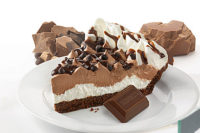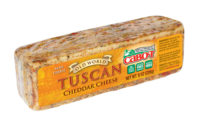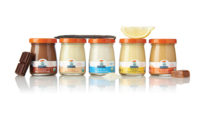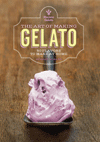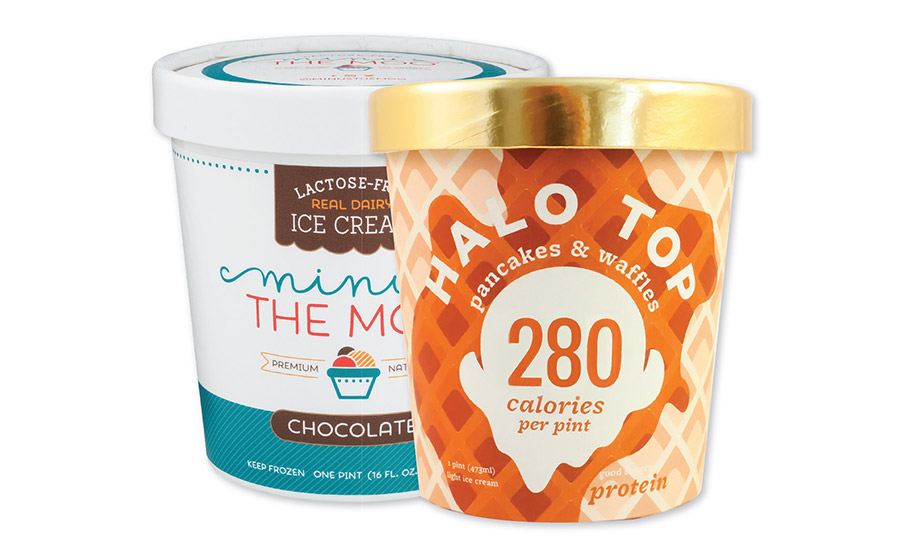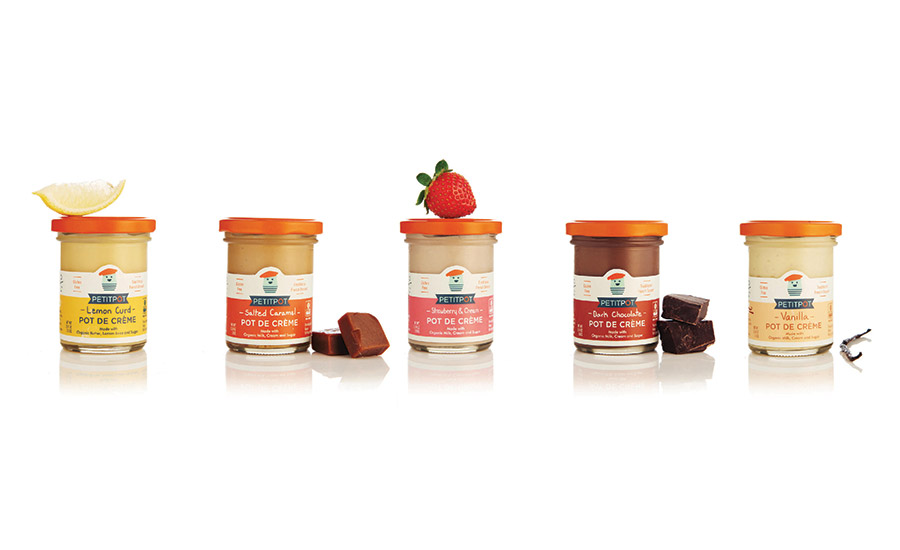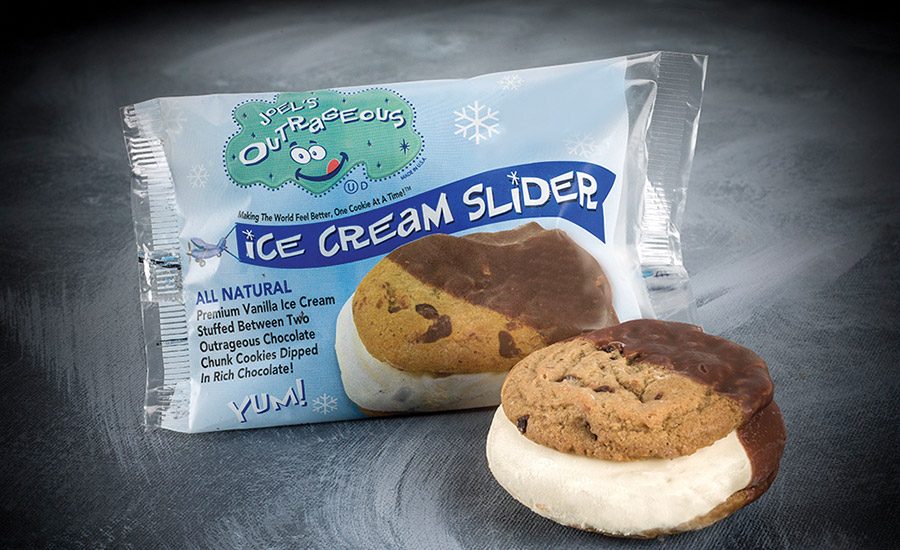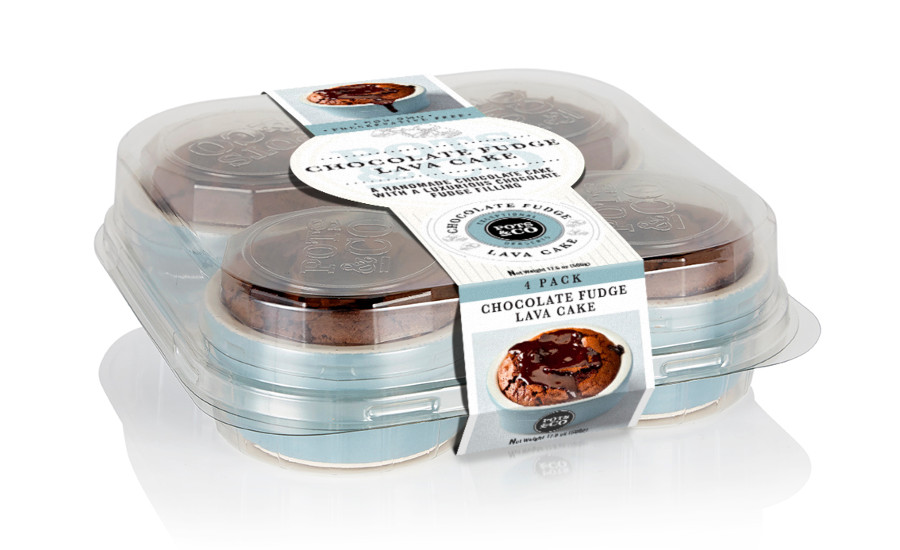Clean ingredients, healthy options dominate in frozen desserts
Ice cream makers are creating new pint lines with lower calories and sugar. Meanwhile, producers of frozen novelties and puddings focus on portion control, packaging and high-quality ingredients.

Too Cool Chix from New York City makes petite ice cream sandwiches. The company is very dedicated to high-quality ingredients and aims to have the “cleanest label ice cream sandwich.”

Ice cream makers aim to reach health-conscious consumers with new pint lines that offer lower sugar, calories (Halo Top), or no lactose (Minus the Moo).

Makers of frozen novelties and pies focus on convenience and portion control. Edwards offers more single-serve pies, My/Mo Mochi’s dough-covered ice cream is grab and go.

Petit Pot’s French-inspired puddings are made with simple, high-quality ingredients and packaged in sustainable glass jars.

Makers of refrigerated puddings are aiming to stand out with clean-label recipes and indulgent flavors.

Revele Belgian Chocolate

Revele Cake Batter

Snoqualmie frozen custard

Too Cool Chix Sammies

Breyers Delights

Joel's Outrageous Ice Cream Slider

Pots & Co. releases a 4-pack of mini chocolate lava cakes in U.S. Costco stores.












Consumers love their ice cream and other frozen and refrigerated treats and prefer them in their most natural forms. There is still a strong desire to eat healthy, but for many, not if it means giving up the indulgence factor. Several ice cream brands have taken on this challenge, creating lines that cut back on calories and sugar but with the mouthfeel consumers expect from ice cream.
Chicago-based Mintel found that despite consumers’ concerns over health many still treat themselves to frozen desserts. According to Mintel, 11% of U.S. consumers report cutting back on ice cream or frozen treat consumption due to health concerns. And 10% say they actively avoid healthy versions because ice cream is meant to be a treat. More than 27% of ice cream buyers agree that, even though they find these treats unhealthy, they buy them anyway.
“Many of the pleasures that consumers get from frozen treats, such as satisfaction of cravings and an enjoyable indulgence, simply outweigh health-related concerns for the vast majority of Americans,” said Mimi Bonnett, director, U.S. Reports, Food, Drink and Foodservice at Mintel.
One way manufacturers are helping consumers satisfy these cravings is through portion control. Brands are releasing more single-serve or pint packages.
“Millennial consumers are snacking more and consuming smaller portion sizes,” said Giselle Restrepo, senior manager of consumer insights and analytics for Schwan’s Co., Marshall, Minn. “Single serve is meeting that need of balancing wholesome, healthy meals and snacks with indulgent foods.”
Consumers’ desire for more natural ingredients is growing across food aisles and dessert is no exception. Manufacturers of ice cream and frozen and refrigerated desserts have taken notice — brands are adding natural and organic lines. Many are touting their quality and clean ingredients on packaging or in marketing campaigns. According to Mintel, premium brands with natural ingredients and innovative flavors have been strong performers.
Ice cream sales are promising
Retail sales of ice cream and frozen novelties reached $12.8 billion in 2016, reflecting a 3.6% year-over-year increase, Mintel said in its April 2017 ice cream report. Market growth has been driven by positive sales performance in the two largest segments: ice cream/frozen dessert and frozen novelties. The ice cream and frozen dairy desserts segment grew 7% from 2014-16 to reach an estimated $6.8 billion, according to Mintel.
The ice cream category saw dollar sales increase 3.7% to $6.7 billion, and unit sales were up 2.6% to 1.7 billion, according to Information Resources Inc. (IRI), Chicago, for the 52 weeks ended June 11, 2017. In the frozen novelties category dollar sales rose 1.6% to $4.9 billion, but unit sales dropped 0.8% to 1.5 billion. See a more detailed look of what’s happening in other frozen dessert sales on page 20.
‘Healthy’ ice cream gets makeover
It appears you can have your “cake” (that is, ice cream) and eat it too. What’s being labeled as “healthy” ice cream has been gaining popularity over the past year. While lower in sugar and calories, these products come in indulgent flavors like birthday cake, s’mores, cake batter and cookies and cream.
“We’re seeing that better-for-you and premium pints are the growing segments of the category. Consumers are looking to reduce their sugar consumption but still satisfy their sweet tooth,” said Jessica Causse senior director of sales and marketing for Huntington Beach, Calif.-based Revelé, a brand of whipped gelato.
Halo Top Creamery, Los Angeles, packages pints of an all-natural, low-cal, low-sugar ice cream in more than 17 flavors, including Birthday Cake, salted caramel and s’mores. The flavors range from 40 to 60 calories, 5 to 7 grams of sugar and 5 grams of protein per ½-cup serving. The ice cream also contains erythritol (a sugar alcohol).
In August, the company announced it was the best-selling pint ice cream in the United States, surpassing companies like Ben & Jerry’s and Häagen-Dazs. Halo Top originally launched in 2012, but has gained popularity in the last couple years thanks to word-of-mouth and social media campaigns.
The company added eight flavors in August, including pancakes and waffles, cinnamon roll, candy bar, rainbow swirl and seasonal pumpkin pie. What’s notable is that Halo Top promotes the nutrition found in a pint, not in a serving. Each of the new flavors ranges from 240 to 360 calories, 5 to 8 grams of sugar, with 20 grams of protein per pint.
Revelé, the whipped gelato, is among the new “healthy” pint lines to launch this summer. It comes in five flavors, including cake batter and coffee toffee crunch. According to Causse, the company is able to use less cane sugar, without sacrificing taste because of the whipping process. It does not use any alternative sugars in its product. The cake batter flavor (which is made with gluten-free flour) contains 90 calories, 4 grams of fat, 6 grams of sugar and 2 grams of protein per 1/2-cup serving. All of the flavors contain 6 grams of sugar or less per serving.
Also new this summer, Unilever’s Breyers, Englewood Cliffs, N.J., introduced Delights in pints. A pint of Delights contains from 260 to 330 calories and 20 grams of protein. Flavors include cookies and cream and chocolate.
Katy Flannery and Gwen Burlingame, the owners behind Minus the Moo, Boston, had a different health mission with their new ice cream — create a product for the lactose-intolerant. Burlingame noted that nondairy ice cream has become a trend among emerging and established brands. But Flannery and Burlingame didn’t want to go that route.
Minus the Moo is the first premium brand of lactose-free ice cream made from milk and cream, according to Burlingame. It is packaged in pints.
“Another trend that we have seen across multiple food categories is gut health and the use of digestive enzymes in food. This fits right in with our use of the lactase enzyme to make our dairy ice cream lactose-free,” she said. “We use real dairy rather than a dairy alternative…so we are able to preserve the creamy, delicious taste and texture of a real, premium ice cream,” she said.
The company currently sells five flavors: sea salt chocolate chip, espresso, mint chip, chocolate and vanilla. A pint sells for about $6.99 in Whole Foods and independent stores throughout New England.
A focus on premium ingredients
Other ice cream brands are choosing to emphasize quality ingredients, are updating packaging, and/or are adding more organic options.
“We’ve seen enormous growth in conventional craft ice cream. We’ve seen a lot of unique and original flavors, as well as contemporary twists on classic flavors. Many brands are cleaning up their labels and offering ice cream with much cleaner ingredients,” said Samantha Hill, director of growth at Snoqualmie Ice Cream, Snohomish, Wash.
She said it feels like the healthy ice cream brands are taking over the category. “But we’re fine with it because our ice creams have 14-19% butterfat and we’re happy to be the antithesis to this trend,” she said.
This year, Snoqualmie released three new flavors in its conventional super-premium line: French toast biscotti, chocolate brownie crunch and salted caramel. The frozen custards are all-natural and GMO-free with 14% butterfat and under 20% overrun. The company also launched what it called a “super-premium organic craft” pint line. The USDA-organic certified ice cream is made with grass-fed milk and is described as French-style frozen custard. The seven flavors include mixed berry, chocolate, vanilla, lavender and salty caramel.
Carlinville, Ill.-based Prairie Farms put the emphasis on simple, quality and natural ingredients with its new line of premium ice cream. The company is marketing it as “Naturally Good Ice Cream.” It’s made with milk, cream, sugar and natural flavors. The line features 21 flavors, including sea salt caramel, chocolate, lemon raspberry cheesecake, country vanilla, Neapolitan, peppermint, rocky road and mint chip.
Make it smaller and portable
The frozen novelty market has seen its own transformation. Manufacturers are focusing on portion control, portability and high-quality ingredients. They market the frozen desserts as snacks.
New York City-based Too Cool Chix makes 2.4-ounce to 2.6-ounce ice cream sandwiches and markets them as all-natural “petite sweet treats.”
Sharon Monahan, CEO of Too Cool Chix, said the company is “fiercely dedicated” to using only the best ingredients. The sandwiches are made without artificial preservatives and no chemical emulsifiers. The company’s goal is to have the “cleanest label ice cream sandwich.”
Flavors include vanilla bean ice cream with a dark chocolate cookie; dark chocolate ice cream with a dark chocolate cookie; and peanut butter ice cream with a dark chocolate cookie. The frozen treats are currently sold in a several shops in Manhattan.
Los Angeles-based My/Mo Mochi Ice Cream markets its rice dough-covered ice cream as portable, sweet snacks. The frozen treats feature ice cream wrapped in sweet, soft dough. They come in seven flavors, including double chocolate, green tea, cookies and cream, strawberry and vanilla bean. The novelties are sold in a 6-pack of 1.5-ounce pieces.
“We’re looking at [ice cream] in a different light. Instead of focusing on the ‘dessert market’ we are looking larger to the snack category,” said Russell Barnett, chief marketing officer for My/Mo Mochi Ice Cream. “With mochi ice cream, consumers get a portable handheld snack, with only 110 calories, while getting to chew their ice cream.”
The Fatboy Cookie Co., Midland Park, N.J., (which specializes in cookie dough) introduced Joel’s Outrageous ice cream sliders, an ice cream sandwich made with its own cookie dough. The frozen dessert features chocolate chunk cookies with vanilla ice cream. Half the sandwich is dipped in chocolate. The sliders are individually wrapped and sold in 3-ounce packages, retailing for $2.99 to $3.99 each.
“[We] decided to call our ice cream sandwiches ‘ice cream sliders’ since the slider hamburger craze is so popular,” said Joel Ansh, president and owner, The Fatboy Cookie Co. “[The sliders are] an all-natural, incredibly rich frozen dessert treat. We’re using a 14% butterfat ice cream and there is a good amount of butter in our chocolate chunk cookies.”
Ice cream companies aren’t the only ones innovating in the frozen dessert market.
Quincy, Mass.-based Yasso, introduced frozen Greek yogurt sandwiches, a first-of-its-kind, according to the company. They are available in two varieties: mint ice cream between dark chocolate cookies and vanilla ice cream between dark chocolate cookies. The mint flavor contains 120 calories, 3.5 grams of fat, 7 grams of sugar and 5 grams of protein per 3-ounce sandwich. They’re sold nationwide in a 4-pack and retail for $4.99.
Schwan’s Co. is putting an emphasis on single-serve options in its Edwards brand of pies. Its single slices come in a 1-pack (in three flavors) and 2-pack (in eight flavors). The 2-pack flavors include chocolate crème, Key lime and Turtle pie. Each pie is about 2.6-ounces. The company added a s’mores flavor to its line this year, in both 2-pack form and whole pie.
“Single-serve items are a great tool to drive trial on whole pies,” said Jessie Joslin, director desserts and Asian-style snacks marketing for Schwan’s Co. She noted that the company also updated its packaging earlier this year for its multiserve and single-serve pies. The packaging features gold ribbon, a new, modernized logo and new food photography focused on showing more appetite appeal.
Make way for fancy puddings
Not to be left out, the refrigerated dessert segment has seen an influx of premium-style puddings. At the Fancy Food show in June, several exhibitors showed high-quality, clean-labeled desserts. These products featured smaller portions, premium flavors, quality ingredients and unique packaging.
Petit Pot, San Francisco, has a line of French-inspired gourmet puddings, including pot de crème and riz au lait (a rice pudding). The 4-ounce puddings are marketed as premium desserts and are packaged in glass jars. The company focuses on simple, high-quality ingredients and touts its sustainable packaging. The puddings are available in five flavors: dark chocolate, vanilla, salted caramel, lemon curd and coffee. They’re made with organic milk and cream, and organic cane sugar. The curd is made with organic butter.
Petit Pot Founder Maxime Pouvreau said, “We are getting great traction in pudding, even though it isn’t supposed to be a hot category, because we are organic, premium [and] have fun branding.”
He added, “The big trend is that big box chains and conventional stores are actively seeking gourmet products that are also organic or clean label. [Consumers] want simplicity and quality across the board and to get that [stores] need to embrace the smaller emerging brands that are doing it best.”
Another company bringing European-style desserts to the United States is Sweetaly Dolceria, Oceanside, Calif. The company makes mousse, tiramisu and panna cotta packaged in 3-ounce glass jars. The company launched lemon ricotta cheesecake at the Fancy Food show. The parfait-like desserts are made with fresh ingredients and no preservatives. The dessert is found in the grab-and-go section of supermarkets.
London-based Pots & Co. entered the U.S. market this year with mini chocolate
fudge lava cakes. The lava cakes are made with butter, double cream, whipping cream and dark chocolate. They are packaged in 4.4-ounce ceramic pots and are sold in five varieties, including chocolate fudge and sticky toffee. The chocolate fudge is sold in a 4-pack at Costco. The company plans to expand to more retailers nationally this fall. It also makes puddings.
Speaking of the packaging, Alex Chamberlain, managing director of Pots & Co. Corp. USA said, “Ceramic offers fantastic heat distribution. And because we pre-bake almost all of our range...our pot is vital to the end result. It helps, of course, that they also have strong stand-out on shelf, and have great reusability in the kitchen and beyond.”
Rodger’s Pudding, Chesapeake, Va., puts its focus on flavors and emphasizes the multipurpose use of its product.
“You can use [our puddings] to make smoothies, blend into foods and infuse into baked goods. You can also use any of the puddings to make pies,” said Reggie Rodgers, co-owner of the company and self-described “head puddin’ pusher.”
The puddings are available in six flavors: banana pudding filling, coconut, guava, blueberry, mango and chocolate. All of the flavors, except for the chocolate (a request by customers), are inspired by events in Rodgers’ life, he said. The banana pudding is based on a recipe from his mother.
Rodgers said the company is a family-owned business that “strives to stand out by being authentic.” All of the puddings are Non-GMO Project-Verified and made with five main ingredients (like pastured raised organic milk and pure cane sugar).
Looking ahead in frozen, refrigerated desserts
Mintel concludes that premium brands with natural ingredients should remain strong, but expanding the market should include promoting lines that balance indulgence and healthier qualities. And for those companies not already doing so, now is the time to offer more portion control or portable options. The dessert market may be competitive, but each category has its own unique qualities to offer. There’s something for everyone.
Looking for a reprint of this article?
From high-res PDFs to custom plaques, order your copy today!




